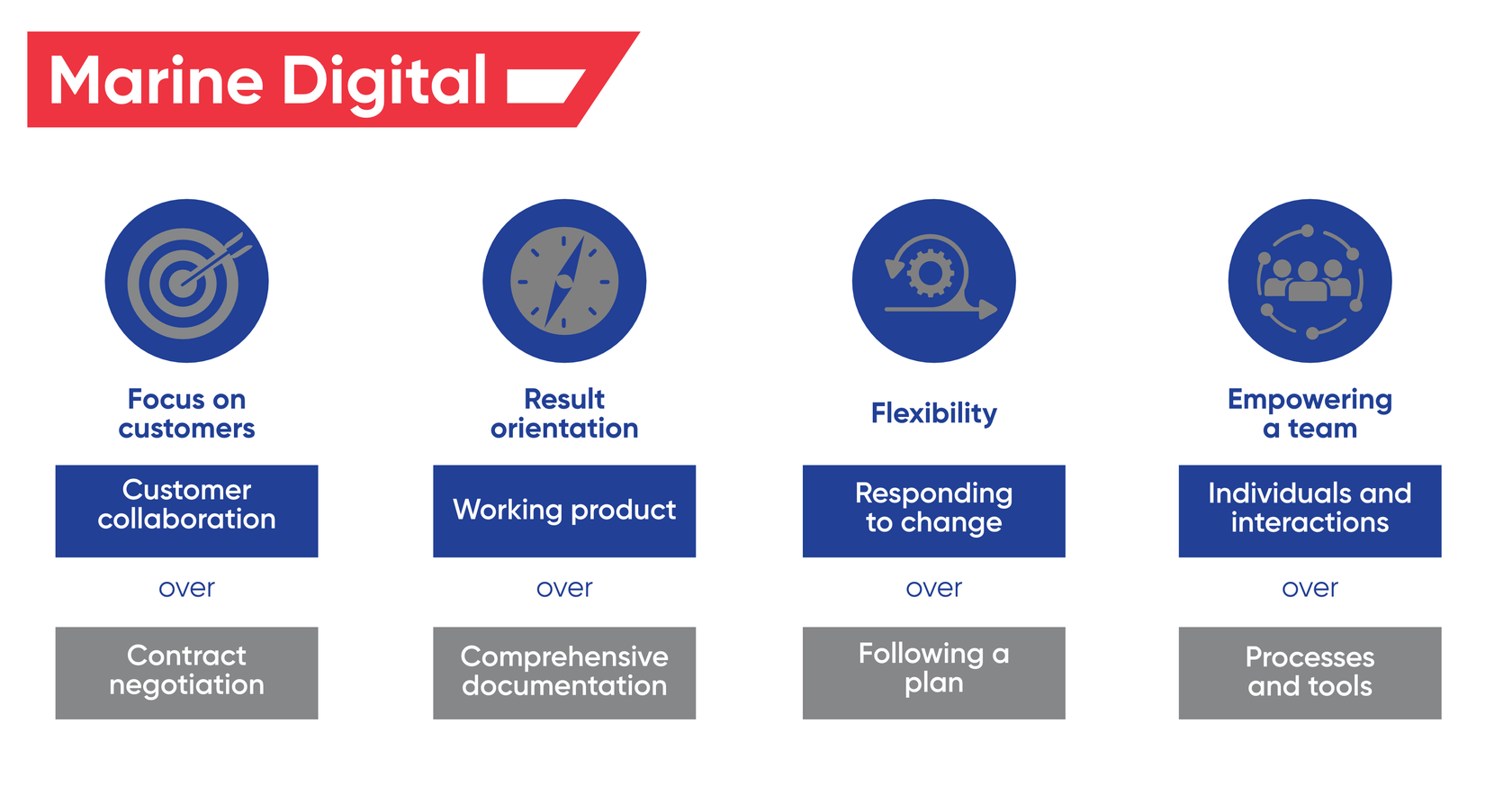Shipping Demands Agile Production and Support
Shipping сompanies can reduce costs by using agile working methods, like collecting feedback from the client, work within the framework of sprints and other attributes of agile
Today's maritime companies have gone through a long period of continuous improvement and are slowly becoming a model for quality and efficiency, thanks in large part to lean processes, methods and examples from other industries. At the same time, the surrounding support functions, both close to the production hall (in the case of companies engaged in shipbuilding or equipment creation), and more technological (companies engaged in the production of software for ships, such as navigation, fuel optimization systems, ship equipment control systems ) interact with production personnel in much the same way they did decades ago.
Leaning manufacturing as equipment and / or ships is very useful for bringing standardized processes to specific goals such as waste reduction, but less efficient with functions that require flexibility and constant adaptation to changing circumstances and conditions. The costs of these ancillary functions account for between 25% and 40% of total manufacturing costs, a share that has grown by about a quarter over the past 20 years as direct costs have declined.
Companies can reduce these costs and add value to support functions by using agile working methods, like collecting feedback from the client, work within the framework of sprints with the subsequent revision of priorities in tasks and other attributes of agile, to which everyone is accustomed to within IT companies.
Leaning manufacturing as equipment and / or ships is very useful for bringing standardized processes to specific goals such as waste reduction, but less efficient with functions that require flexibility and constant adaptation to changing circumstances and conditions. The costs of these ancillary functions account for between 25% and 40% of total manufacturing costs, a share that has grown by about a quarter over the past 20 years as direct costs have declined.
Companies can reduce these costs and add value to support functions by using agile working methods, like collecting feedback from the client, work within the framework of sprints with the subsequent revision of priorities in tasks and other attributes of agile, to which everyone is accustomed to within IT companies.
Agile methods add value to production and support
- Focus on customers means flexibility and working with clients on emerging issues, rather than trying to discuss all the details with them in advance. As part of customer complaint resolution processes, internal transfers between different departments or functions are performed by cross-functional teams that have the ability to collaborate and resolve customer problems faster.
- Results orientation puts the emphasis on developing a work product, rather than on the documentation that supports it.
- Flexibility helps you deal with unforeseen problems as production grows. Instead of following a rigid plan, different teams can adjust the work plan and change machines and processes. They work with quality control personnel to ensure on-time production with the highest possible quality while improving the preliminary process developed by the prototype teams.
- Empowering a team means that teams have the right to determine how to achieve their goal and to decide what processes and tools they want to use. Critical to this empowerment is that teams have all the cross-functional capabilities needed to deliver results at the right level.
In most manufacturing and development processes, costly lead times have several causes. First, the timing of support functions and core business processes varies greatly. Another problem is disparate functions, which tend to slow down handover between functions and lead to failures. A typical example is the lack of a link between quality and design, which increases the lead time required to resolve customer complaints.
The fragmented effort slows down the work. When people are forced to direct their attention in multiple directions, tasks can accumulate, resulting in long wait times and quality problems. Functions are also often neglected by their internal clients. Increased lead times can occur when, for example, supply chain planning moves forward on an ambitious schedule without considering associated production constraints.
Strict adherence to the manufacturing process in the face of changing production needs can lead to unnecessary delays. For example, if it adheres to the weekly hiring process for temporary workers, the company will not be able to respond to the production growth projected for the next week.
Agile can help solve all of these problems. It is based on four pillars: customer orientation, result orientation, adaptability and team empowerment.
The fragmented effort slows down the work. When people are forced to direct their attention in multiple directions, tasks can accumulate, resulting in long wait times and quality problems. Functions are also often neglected by their internal clients. Increased lead times can occur when, for example, supply chain planning moves forward on an ambitious schedule without considering associated production constraints.
Strict adherence to the manufacturing process in the face of changing production needs can lead to unnecessary delays. For example, if it adheres to the weekly hiring process for temporary workers, the company will not be able to respond to the production growth projected for the next week.
Agile can help solve all of these problems. It is based on four pillars: customer orientation, result orientation, adaptability and team empowerment.

In shipbuilding, agile working methods are organized around two types of teams and apply to both production and support functions. Flexible Manufacturing Units are based on Lean Autonomous Manufacturing Units. Each flexible manufacturing division includes manufacturing and direct support functions such as planning and scheduling, quality control and logistics. Other support functions such as customer service, quality assurance, regulatory compliance, and sourcing are organized into teams (often referred to as tribes) that serve within agile support teams and provide indirect support while operating in a new integrated operating model. The tribes are empowered to work closely with agile manufacturing units to achieve common goals.
The Agile Operating Model addresses the causes of lead time issues described above. He breaks up silos, separating production and other functions. Teams of people with the right knowledge are empowered to solve complex problems at the operational level, rather than to put out fires when production problems arise. Site management and support experts only intervene when needed. Agile manufacturing divisions prioritize work with one goal: achieving a manufacturing goal within performance targets.
An agile development will not necessarily increase productivity per unit, but it will perform at a higher level in terms of time, cost and quality when dealing with unusual situations and problems. It will go beyond physical production to add value in support areas such as product design, customer service, quality, and compliance.
The Agile Operating Model addresses the causes of lead time issues described above. He breaks up silos, separating production and other functions. Teams of people with the right knowledge are empowered to solve complex problems at the operational level, rather than to put out fires when production problems arise. Site management and support experts only intervene when needed. Agile manufacturing divisions prioritize work with one goal: achieving a manufacturing goal within performance targets.
An agile development will not necessarily increase productivity per unit, but it will perform at a higher level in terms of time, cost and quality when dealing with unusual situations and problems. It will go beyond physical production to add value in support areas such as product design, customer service, quality, and compliance.
Since the agile process is new to the shipping industry in general, it is recommended that companies start small, with one or two pilot projects, and allow employees to become familiar with the concept of agile and work in new types of teams to achieve common goals. Service desk personnel, in particular, need to adapt from working on process-oriented goals to achieving customer- and quality-centered goals. There are three steps.
1. Choose where to start. This could include creating flexible manufacturing units with manufacturing personnel and direct support personnel, or transforming the way support functions work with manufacturing to address a key strategic challenge. Companies with mature lean processes may find the flexible manufacturing unit option simpler as it builds on existing autonomous manufacturing units. The second route is preferable in situations requiring intensive and fast multifunctional cooperation, such as launching a new product, fighting for pole position in a large market, or improving quality.
2. Determine the main business goal ("what") and target vision ("how"). The goal must be bold so that employees cannot succeed without thinking outside the box. Examples include cutting the extra production hours in half or reducing the number of non-conformities at the end of the production line to zero. For support functions, the goal may be to reduce the time it takes to resolve customer complaints. It should also serve to bring agile teams together to achieve one goal.
At the same time, the target vision should help employees understand what Agile should look like. It should include considerations such as sharing customer feedback, how agile problem-solving lags are being bridged, how teams are exploring alternative solutions, and how support functions are built into procedures.
3. Reorganization based on a targeted vision using an agile methodology. Determine the skills and knowledge required to solve the problem. Identify cross-functional team leaders tasked with achieving goals in their area. For example, in the above customer complaint case, there might be a supervisor for complaints about Product A and one about Product B. Get the teams to work and make sure there are frequent opportunities for escalation. Do not introduce any processes or procedures. Teams need to feel motivated to achieve the goal and be able to make the company better in that area.
Agile may not be right for every marine logistics company or situation. But adapting flexible principles of cross-functionality, collaboration, customer focus, and adaptability can alleviate major pain points in the manufacturing process and help improve collaboration between manufacturing and support functions. It is worth exploring the potential benefits in terms of cost savings and increased customer and employee satisfaction.
Read also Maritime technology challenges 2030
and Download for free the Guidelines on cybersecurity onboard ships
1. Choose where to start. This could include creating flexible manufacturing units with manufacturing personnel and direct support personnel, or transforming the way support functions work with manufacturing to address a key strategic challenge. Companies with mature lean processes may find the flexible manufacturing unit option simpler as it builds on existing autonomous manufacturing units. The second route is preferable in situations requiring intensive and fast multifunctional cooperation, such as launching a new product, fighting for pole position in a large market, or improving quality.
2. Determine the main business goal ("what") and target vision ("how"). The goal must be bold so that employees cannot succeed without thinking outside the box. Examples include cutting the extra production hours in half or reducing the number of non-conformities at the end of the production line to zero. For support functions, the goal may be to reduce the time it takes to resolve customer complaints. It should also serve to bring agile teams together to achieve one goal.
At the same time, the target vision should help employees understand what Agile should look like. It should include considerations such as sharing customer feedback, how agile problem-solving lags are being bridged, how teams are exploring alternative solutions, and how support functions are built into procedures.
3. Reorganization based on a targeted vision using an agile methodology. Determine the skills and knowledge required to solve the problem. Identify cross-functional team leaders tasked with achieving goals in their area. For example, in the above customer complaint case, there might be a supervisor for complaints about Product A and one about Product B. Get the teams to work and make sure there are frequent opportunities for escalation. Do not introduce any processes or procedures. Teams need to feel motivated to achieve the goal and be able to make the company better in that area.
Agile may not be right for every marine logistics company or situation. But adapting flexible principles of cross-functionality, collaboration, customer focus, and adaptability can alleviate major pain points in the manufacturing process and help improve collaboration between manufacturing and support functions. It is worth exploring the potential benefits in terms of cost savings and increased customer and employee satisfaction.
Read also Maritime technology challenges 2030
and Download for free the Guidelines on cybersecurity onboard ships
How to build and agile workflow

TOP 5 factors contributing to lower fuel costs for Shipping companies
Get a presentation with a full description of the features and free pilot project with trial of Marine Digital FOS for 2 months
"Clicking the button, you consent to the processing of personal data and agree to the privacy policy"

Get an overview "The Pathway to Zero Carbon Shipping:
IMO Compliance and CII Optimization through SEEMP" on email and download it for FREE! Leave your email now!
"Clicking the button, you consent to the processing of personal data and agree to the privacy policy, as well as consent to subscribe to the newsletter. "
Аdvantage of Fuel Optimization System from Marine Digital:

Marine Digital FOS can be integrated with other system and third-party's solutions through the API. To implement vessel performance monitoring for any vessel, we are using mathematical algorithms, machine learning and the same equipment as in FOS. The more data we collect from vessels, the more precise reports and recommendations our system will perform according to your individual requirements in fleet management.
If you have any questions about the solutions and the Marine Digital System platform, write to us, we will be happy to answer
If you have any questions about the solutions and the Marine Digital System platform, write to us, we will be happy to answer

Increased business process speed

Reducing to zero the number of errors

Best offer to the clients

Reduction in operating expenses
Have a questions?





